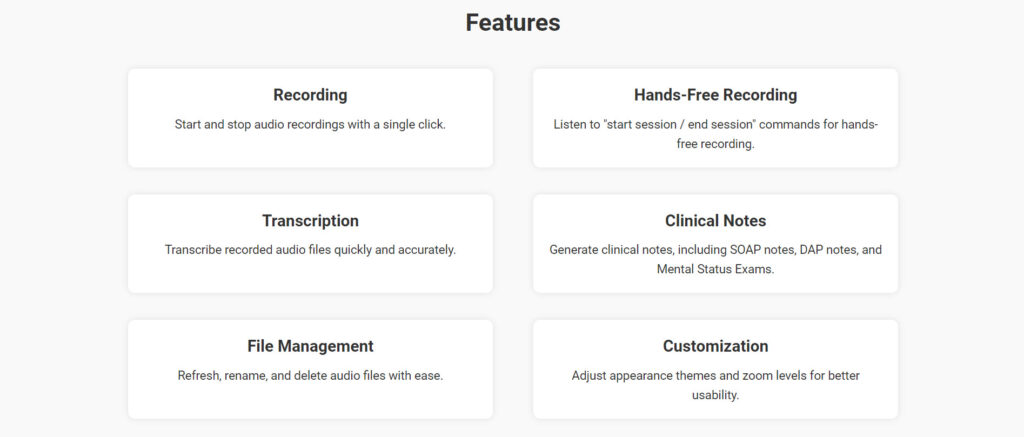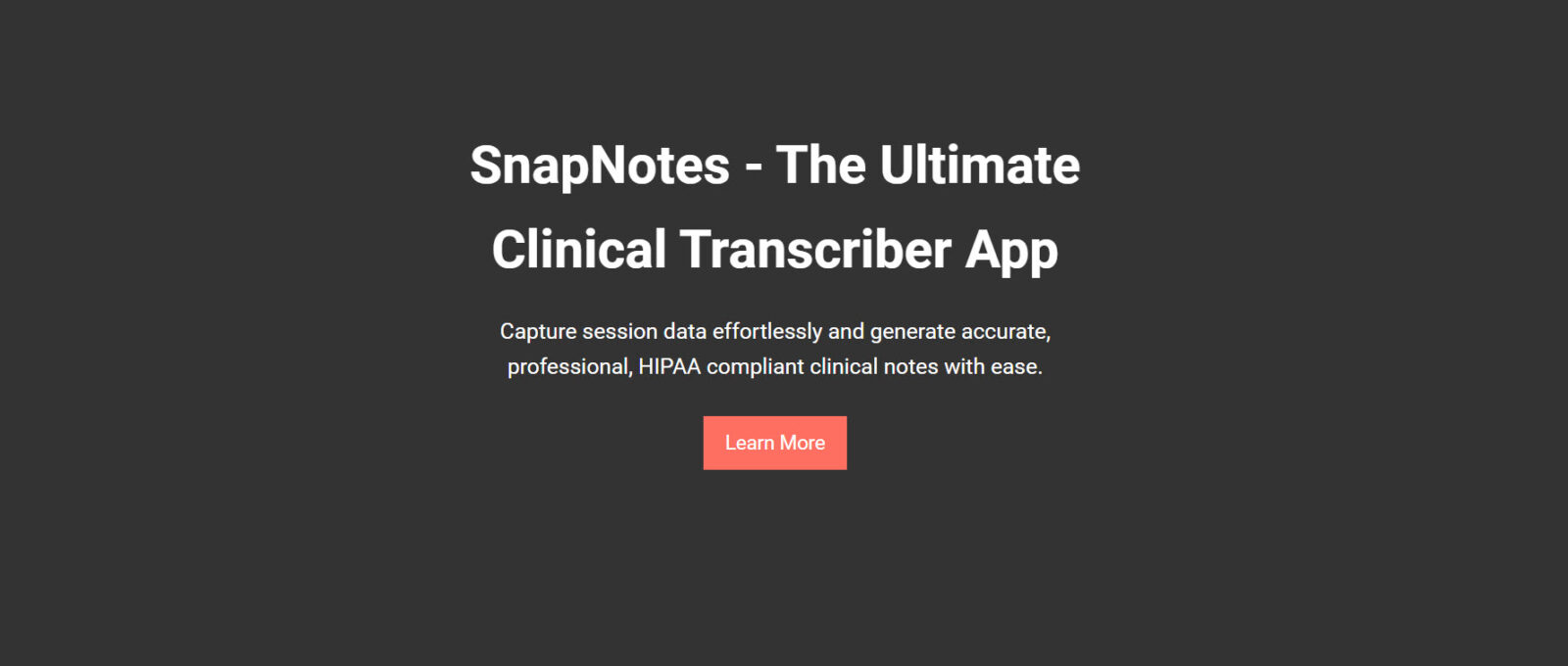Hello! What’s your background, and what inspired you to create SnapNotes?
My background is diverse. I am a licensed clinical social worker (LCSW) and work as a mental health therapist in my own private practice. I have extensive experience working directly with clients and managing clinical documentation. Additionally, I’ve worked as a quality improvement analyst in behavioral health. My undergraduate degree is in fine art, and I am also a painter and amateur musician. I like to think that my love for programming and tech ties all my interests together in creative ways.
The inspiration for SnapNotes, a clinical transcriber app, came from personally feeling overwhelmed by administrative burdens as a therapist, knowing that my experience isn’t unique. Therapists and healthcare providers have long needed more efficient admin solutions to streamline the clinical documentation process, allowing more focus on client care. With technological advancements in artificial intelligence, I realized that such a solution was within reach.
How did you identify the need for a clinical transcriber app in the market?
The need for a clinical transcriber app became apparent through my professional experience and conversations with colleagues. Many therapists struggle with the time-consuming nature of documentation, which often detracts from direct client interaction. Additionally, maintaining high standards of confidentiality and accuracy in clinical notes highlighted the potential benefits of an automated solution that could handle these tasks efficiently and securely.
Consider this: Medicare and Medicaid plans serve individuals often most in need of therapy. However, the documentation burden for these plans can be so great that many therapists avoid participating in them. The cost-to-benefit analysis for many just doesn’t make financial sense. We feel strongly that if our product can help convince even a small percentage of therapists to consider joining public plans, we will have done a significant service not only for providers but for communities in need of more services.
Can you walk us through the development process of SnapNotes from the initial idea to the current beta version?
The development of our clinical Transcriber app, SnapNotes, began with a clear identification of the problem and extensive research into existing solutions. We started with brainstorming sessions and prototyping to define the core features.

The development phase involved integrating advanced technologies like Whisper for transcription and a proprietary scrubber for handling PHI. We focused on ensuring the app met HIPAA compliance standards while providing a user-friendly interface. After internal testing, we moved to the beta version, inviting a select group of users to provide feedback and help us refine the product.
Also, could you walk us through the steps on how SnapNotes works from capturing session data to generating HIPAA-compliant clinical notes?
Capture Session Data: Users start and stop audio recordings directly within the app. We also developed a hands-free capability where users can say “start session” and “end session” to initiate recording, integrating SnapNotes seamlessly into therapy sessions.
Transcription: The recorded audio is transcribed locally on the user’s device using Whisper, ensuring no data leaves the device.
Scrubbing PHI: Our proprietary scrubber processes the transcribed text to remove any PHI, ensuring HIPAA compliance. Users can review outputs to ensure accuracy and efficacy of the de-identification process.
Generate Notes: Users select the preferred note format (SOAP, DAP, etc.), and SnapNotes generates accurate, professional clinical notes ready for review and integration into EHR systems. This final step involves an API connection to OpenAi’s external service, using the deidentified text.
What was the initial budget for developing SnapNotes?
The initial budget for developing SnapNotes was modest, as I bootstrapped the project. I allocated funds primarily for essential development tools, focusing on core functionality and gradually scaling up as I gathered user feedback and validated the market need. While I am the director of the SnapNotes project and handle all of the development, my wife has been an invaluable informal advisor. This truly embodies the “citizen developer” concept, leveraging powerful technologies like AI to create meaningful projects based on a solid understanding of user needs.
How did you go about recruiting beta testers for SnapNotes?
We recruited beta testers mostly through word of mouth in our professional networks. We specifically invited mental health professionals who could provide valuable insights into the app’s usability and effectiveness. Additionally, we are offering early access incentives to encourage participation and gather diverse feedback. A lot of what we do is very DIY. We have strong relationships with folks in the mental health community and they know when an idea is worth trying out. The next step will be to expand an invitation to participate through social media platforms like Facebook and Reddit.
How has the reception been from the clinical community since introducing SnapNotes to beta testers?
The reception from the clinical community has been promising. One beta tester believes SnapNotes will save time, while another is exploring the possibility of bringing it into their organization for testing. We have an upcoming demo with a company expressing excitement about our clinical transcriber app, and both my wife and I have tested it with positive results. We’re eager to gather more comprehensive feedback and refine the app further. There’s also interest in expanding functionality to cover additional note types and other health professions like home health, nursing, and peer services.
What metrics are you using to measure the success and effectiveness of SnapNotes during the beta testing phase?
We are using several key metrics to measure success, including:
- User Engagement: Frequency of app usage and feature adoption.
- Feedback Quality: Detailed feedback on functionality and usability from beta testers.
- Time Savings: Reduction in time spent on documentation compared to manual methods.
- Error Rates: Accuracy of transcriptions and note generation.
- User Satisfaction: Overall satisfaction ratings and willingness to recommend SnapNotes to colleagues.
What are the next steps for SnapNotes after the beta testing phase?
After the beta testing phase, our next steps include in our healthcare transcription app:
- Incorporating Feedback: Implementing improvements based on beta tester feedback.
- Scaling Up: Expanding our user base through targeted marketing and partnerships.
- Continuous Development: Adding new features and enhancing existing ones to meet evolving user needs.
- Compliance and Security: Ensuring ongoing compliance with HIPAA and other regulations.
- Support and Training: Providing comprehensive support and training resources for users to maximize the app’s benefits.
- Monetization: Converting our free beta version to a paid model, with ongoing market analysis to ensure competitive pricing.
Where can people find more information or resources about SnapNotes?
Website: SnapNotes.ai
Facebook: EMITS.ai (another project page where users can reach us)
Website: Emits.ai
Contact us: contact@umetlab.com
Did you enjoy this interview with SnapNotes founder – an healthcare clinical app? I regularly interview creators who have recently launched their products. Check out additional discussions like this on BetaHunt. For updates, follow me on X.

Leave a Comment